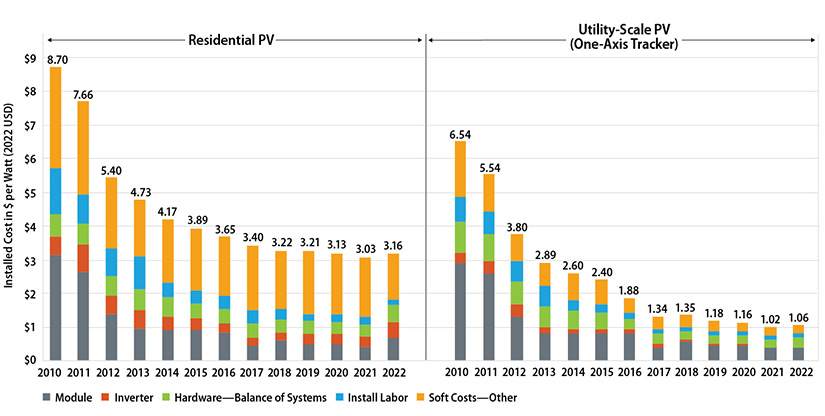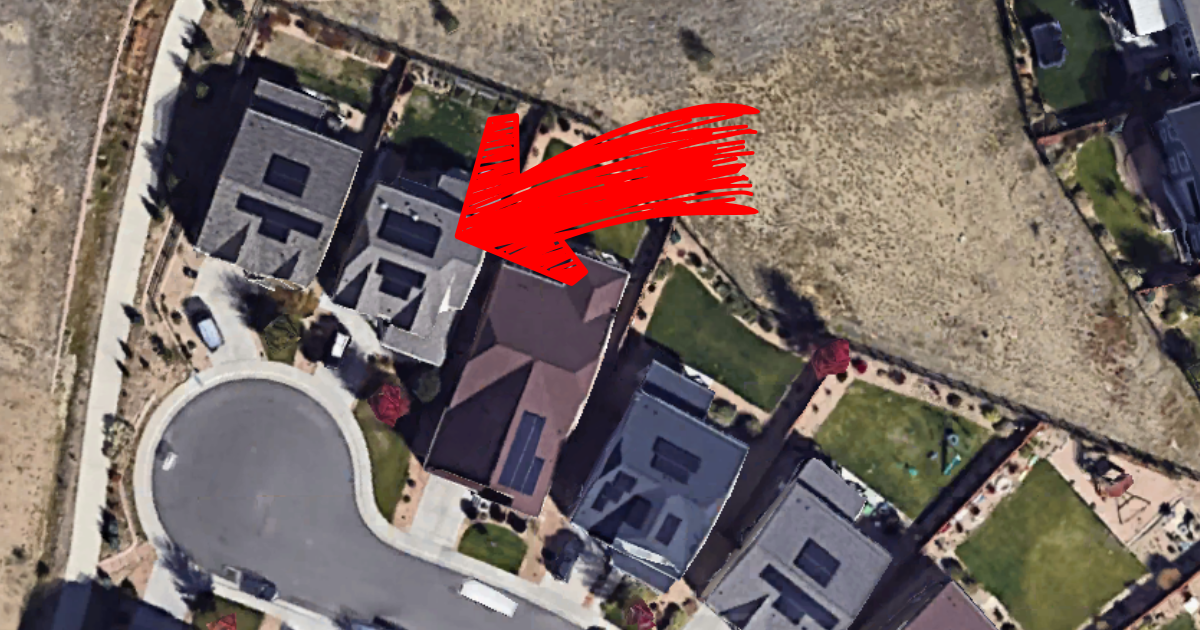In the early days of residential solar power, installing panels on north-facing roofs was generally considered a poor practice. You may have heard it before, or it may just make logical sense, “never place solar facing North.” However, as solar technology has advanced and become more widespread, the conventional wisdom has shifted.
More and more frequently, Homeowners are asking us about the feasibility of placing solar panels on the north-facing slopes of their roofs, often after receiving quotes from reputable companies suggesting this layout. This raises an important question: So, what gives? Is this a sensible approach, or are salespeople simply trying to sell us a larger system?
Solar PV Cost History
Fifteen years ago, residential solar design was quite different from what it is today. Back then, solar systems were considerably more expensive, with the cost breakdown heavily weighted towards the solar modules themselves.

As shown above in the figure from NREL’s bottom-up cost modeling, there are a number of major factors that go into the price of the system. You have the expected components like modules, inverters, and labor, but you also have components such as the Balance of System (racking, wiring, fasteners, etc), permitting costs, and overhead & profit.
These categories are relatively unchanged since the early days of solar. What has changed is the percentage of the total system costs each of these catorgies represent. You might be suprised to hear that today the solar modules only account for a portion of the cost. All the red tape and cost of doing busness can account for more than the solar itself.
That wasn’t always the case, back 15 years ago solar modules were the most expensive single aspect of the system. Have a look at this chart below from NREL. Notice the Dark grey portion of the residtial systems on the left. In 2010 the module cost alone cost more than the entire installed cost of a system today!

Hardware Cost Design Considerations
With modules once being the most expensive component, design strategies focused on maximizing energy harvest. This often involved selecting larger inverters that were a bit more expensive, but would be sized to never clip, and positioning panels to optimize sun exposure. For example, in the past, a 1:1 DC to AC ratio was standard practice, ensuring that the inverter capacity matched the module capacity. This approach minimized any loss of potential energy generation from the expensive modules, even on the sunniest days of the year. Additionally, tilt-up racking was sometimes added to pitched roofs to achieve the optimal tilt angle, maximizing performance, even though it cost quiet a bit more in labor and materials to do so for only a couple percent more annual yeild.
In those days, placing panels on a north-facing roof was avoided. The high cost of modules made it impractical to install them where they would receive less sunlight. The payback period for a system was already lengthy, and installing panels in a suboptimal position could extend it to a point that did not make financial sense.
Today’s Effeceint System Designs
Today, the cost structure of solar systems has changed dramatically. Modules are now more affordable, and their cost is no longer the magr aspect of the overall system cost. This shift has led to new design paradigms, such as using a 1:1.2 (or higher) DC to AC ratio. This means installing more DC capacity than the inverter can utilize at those peak points of the year, a practice known as “over-paneling.” The reasoning is simple: solar arrays rarely operate at their maximum capacity due to factors like weather and shading. Thus, a slightly undersized inverter is a cost-effective choice, even if it occasionally results in clipping (where the inverter limits the power output). Although clipping is apparent on online monitoring platforms, the periods of clipping add up to only a small percentage of teh operational time each year. Often just minutes a day, certain months of the year.
Similarly, the practice of adding tilt-up racking has become less common. The additional cost of achieving the ideal tilt angle on a pitched roof often outweighs the benefits. Now that the modules are less expensive, it is more economical to add additional panels and mount them flush with the roof, even if the angle of the roof losses a few percentage of annual generation due to not being ideal.
Design Goals
A critical aspect of solar design that is rarely discussed is what the homeowner hopes to accomplish with the system. Many people do not realize that it is not just a matter of how much solar will fit on their roof; the design itself can (and should) take into account the goals for the system.
The primary design in today’s market often focuses on financial optimization rather than maximizing energy yield as was more common a decade ago. Designing for finicials involves designing a system that provides the best return on investment, which may include choosing a smaller capacity inverter with some level of clipping during peak production times, which the initial cost savings may be greater than 30+ years of missed peak production. It may also include a bit smaller array, with modules placed only on the most productive locations on the roof.
Conversely, designing for maximum yield might involve choosing a larger inverter that costs a bit more, but never clips. Also placing panels in less-than-ideal locations to capture every possible watt of energy, even if those modules in less ideal locations incease the time to “break-even”. This approach may have a longer payback period, but generates some amount more energy each month.
Conclusion: The Case for a North Facing Array
Installing solar panels on a north-facing roof can still be a viable option, especially given the current low cost of PV modules. This design choice may appeal to system owners who prioritize maximizing monthly energy yield over achieving the shortest possible payback period. While north-facing panels typically produce less energy compared to those facing south, the lower cost of PV technology makes it feasible. Additionally, homeowners may have aesthetic or practical reasons for utilizing all available roof space.
So I will end with this. While conventional wisdom still favors south-facing solar panels in full sun for optimal performance, north-facing installations can be a reasonable choice if the homeowner is fully aware of the design trade-offs. Simply using north-facing roof slopes to sell a larger system can border on fraudulent practices. However, if the trade-offs are clearly understood and the homeowner consciously opts for a less financially efficient design in exchange for greater monthly yield, there is a valid case for utilizing a north-facing roof.

